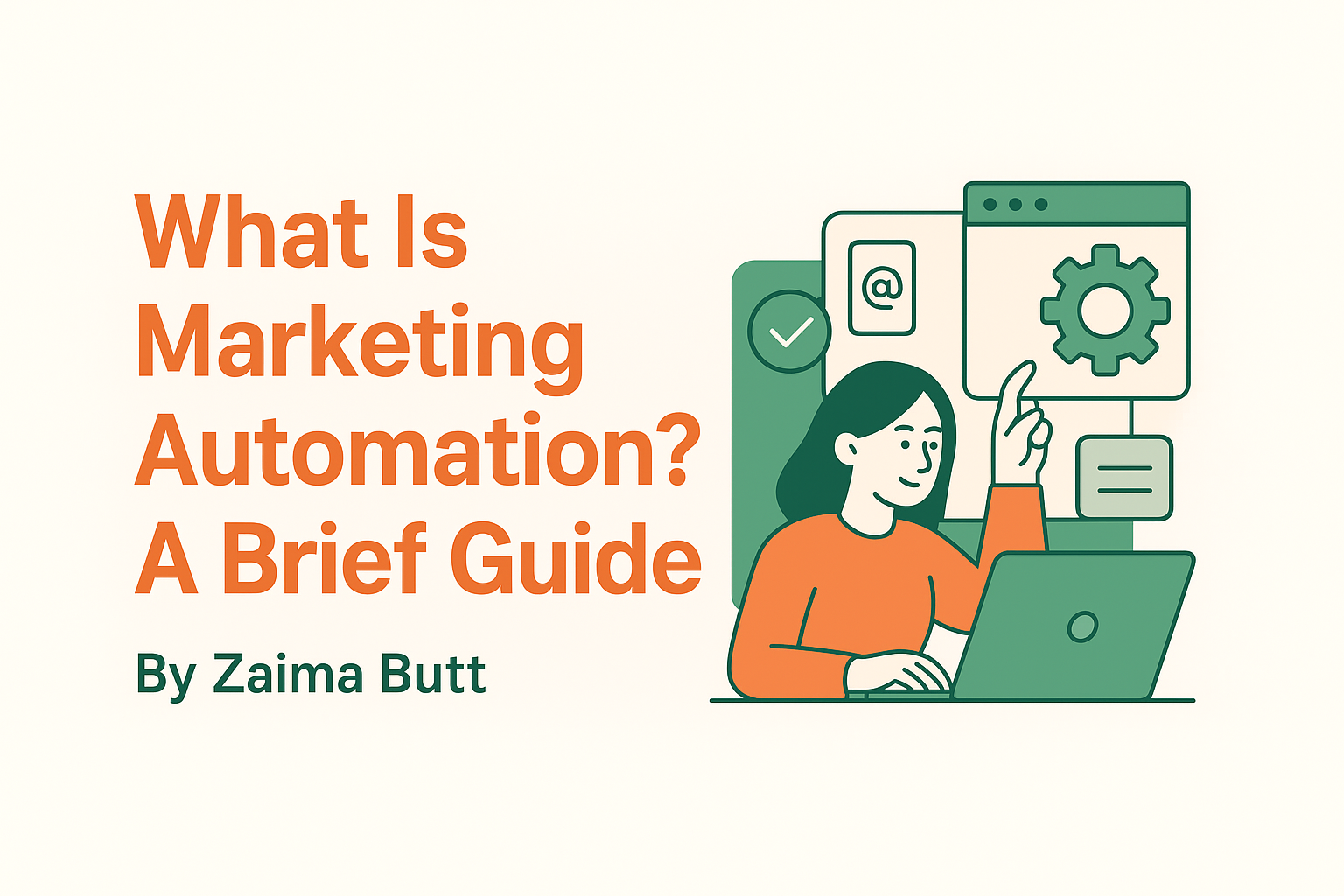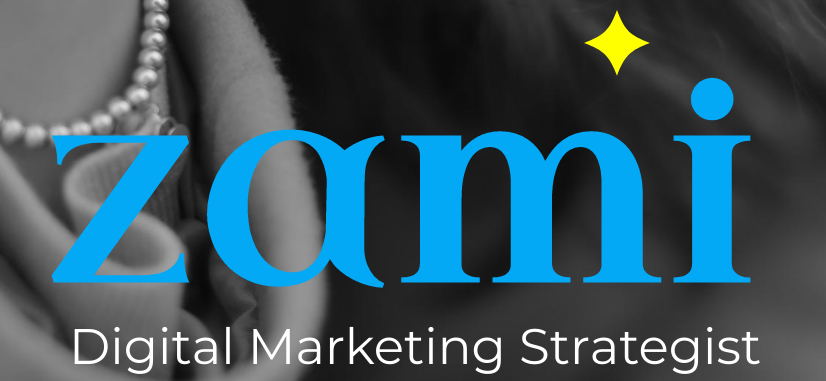What Is Marketing Automation? A Brief Guide

If you’ve ever wondered “What exactly is marketing automation?”, you’re in the right place. In this article I’ll walk you through everything you need to understand this powerful tool — from the basics to how you can use it, and the key best-practices to succeed. What is Marketing Automation? Simply put, marketing automation is the process of using technology to automate repetitive marketing tasks — helping you deliver the right message, to the right person, at the right time. (Sprout Social)It goes well beyond just sending emails — it may include automating social media posts, SMS notifications, lead scoring, segmentation, campaign workflows, and coordinating across multiple channels. (Sprout Social) Why It Matters (and What It Can Do for You) Core Components of a Marketing Automation Strategy 1. Audience Segmentation & Lead Scoring Before you automate, you must know who you’re targeting. That means defining buyer personas, segments, and then using lead scoring to identify which leads are ready to move forward. (The CMO) 2. Trigger-Based Workflows & Automation Rules A big part of marketing automation is setting up triggers (for example, someone downloads an e-book, visits a pricing page, abandons a cart) and defining what happens next: send a follow-up email, assign to sales, display an ad, etc. (Sprout Social) 3. Content & Multi-Channel Delivery You’ll want to deliver the right content via the right channel: email, social media, SMS, web-push, perhaps chatbots. Automating the delivery ensures you stay relevant and timely. (UserGuiding) 4. Integration with CRM and Data Systems An automation tool works best when it integrates with your CRM (customer relationship management) system and other data sources. That ensures your workflows are data-driven and your customer journey is unified. (The CMO) 5. Analytics, Measurement & Optimization Automation is not “set it and forget it.” You need to track results: open rates, click-throughs, conversion rates, revenue impact, etc. Then refine your workflows, tweak triggers, test variations (A/B testing). (Factors) How to Implement Marketing Automation — Step by Step Here’s a practical roadmap you can follow. Step 1 – Define Your Goals & Success Metrics Start with clarity: Do you want to generate more leads? Increase customer retention? Improve cross-sell/upsell? Decide what “success” looks like and how you’ll measure it (e.g., number of MQLs, conversion rate, revenue per campaign). Step 2 – Map Your Customer Journey & Identify Automation Opportunities Chart how someone goes from “just browsing” → “interested” → “ready to buy” → “loyal customer.” Then ask: where can we automate touch-points? Where are drop-offs? What content needs to be triggered? (The CMO) Step 3 – Choose the Right Platform & Tools There are many marketing automation platforms; pick one that fits your team size, channels, budget, and integrates with your existing systems (CRM, CMS, analytics). Step 4 – Build Your Workflows & Set Triggers Start simple. For example: Step 5 – Create & Organize Your Content Prepare the content that supports each stage: awareness (blog posts, infographics), consideration (webinars, case studies), decision (trial offers, demos). Automate delivery according to workflow. Step 6 – Test, Measure & Optimize Use A/B testing, analyze your metrics, refine your segments, adjust triggers. Automation doesn’t mean “hands-off” — it means “smarter”. (Factors) Step 7 – Scale & Expand Once your initial workflows are delivering value, expand: integrate social media automation, SMS/mobile push, more complex nurture sequences, predictive analytics, AI-driven personalization. (Braze) Key Best Practices & Pitfalls to Avoid Best Practice – Know Your Audience Deeply Make sure your segmentation is meaningful. If you don’t know your audience, automation won’t hit its mark. (The CMO) Best Practice – Keep Workflows Simple at First Complex is tempting, but simpler often delivers faster results and easier optimization. (The CMO) Best Practice – Use Personalization & Relevant Content Personalized workflow messaging (based on behaviour, demographics, preferences) wins attention. (Constant Contact) Pitfall – Sending Generic Automated Messages Automation is a tool — not an excuse for impersonal, generic messages. It must still feel human. Pitfall – Not Aligning Sales & Marketing If your marketing automation operates in a silo and doesn’t communicate with sales or CRM data, you’ll lose alignment, and leads may fall through cracks. (The CMO) Pitfall – Forgetting to Measure & Update Automation isn’t “set it and leave it.” Trends change, data evolves, channels shift. You need regular reviews. Trends and the Future of Marketing Automation Final Thoughts If you’re ready to take your marketing to the next level, marketing automation is no longer optional — it’s essential. By following the steps above, focusing on good strategy, and staying aligned with your audience, you’ll be able to free up time, scale smarter, and deliver better results.
What Is Marketing Automation? A Brief Guide

If you’ve ever wondered “What exactly is marketing automation?”, you’re in the right place. In this article I’ll walk you through everything you need to understand this powerful tool — from the basics to how you can use it, and the key best-practices to succeed. What is Marketing Automation? Simply put, marketing automation is the process of using technology to automate repetitive marketing tasks — helping you deliver the right message, to the right person, at the right time. (Sprout Social)It goes well beyond just sending emails — it may include automating social media posts, SMS notifications, lead scoring, segmentation, campaign workflows, and coordinating across multiple channels. (Sprout Social) Why It Matters (and What It Can Do for You) Efficiency & time-savings: It frees your team from manual, repetitive work so you can focus on strategy and creativity. (Sprout Social) Scale & consistency: You can reach more leads or customers without sacrificing personalization. Better alignment with your audience’s journey: By automating your marketing workflows, you can map out how someone moves from awareness → consideration → decision, and deliver tailored content at each stage. (The CMO) Improved ROI: Studies find that companies using marketing automation can grow their pipeline significantly, increase revenue, and allow sales to spend more time selling. (Adobe for Business) Core Components of a Marketing Automation Strategy 1. Audience Segmentation & Lead Scoring Before you automate, you must know who you’re targeting. That means defining buyer personas, segments, and then using lead scoring to identify which leads are ready to move forward. (The CMO) 2. Trigger-Based Workflows & Automation Rules A big part of marketing automation is setting up triggers (for example, someone downloads an e-book, visits a pricing page, abandons a cart) and defining what happens next: send a follow-up email, assign to sales, display an ad, etc. (Sprout Social) 3. Content & Multi-Channel Delivery You’ll want to deliver the right content via the right channel: email, social media, SMS, web-push, perhaps chatbots. Automating the delivery ensures you stay relevant and timely. (UserGuiding) 4. Integration with CRM and Data Systems An automation tool works best when it integrates with your CRM (customer relationship management) system and other data sources. That ensures your workflows are data-driven and your customer journey is unified. (The CMO) 5. Analytics, Measurement & Optimization Automation is not “set it and forget it.” You need to track results: open rates, click-throughs, conversion rates, revenue impact, etc. Then refine your workflows, tweak triggers, test variations (A/B testing). (Factors) How to Implement Marketing Automation — Step by Step Here’s a practical roadmap you can follow. Step 1 – Define Your Goals & Success Metrics Start with clarity: Do you want to generate more leads? Increase customer retention? Improve cross-sell/upsell? Decide what “success” looks like and how you’ll measure it (e.g., number of MQLs, conversion rate, revenue per campaign). Step 2 – Map Your Customer Journey & Identify Automation Opportunities Chart how someone goes from “just browsing” → “interested” → “ready to buy” → “loyal customer.” Then ask: where can we automate touch-points? Where are drop-offs? What content needs to be triggered? (The CMO) Step 3 – Choose the Right Platform & Tools There are many marketing automation platforms; pick one that fits your team size, channels, budget, and integrates with your existing systems (CRM, CMS, analytics). Step 4 – Build Your Workflows & Set Triggers Start simple. For example: When a visitor downloads a whitepaper → send a welcome email + assign to nurture stream. If that lead visits pricing page → send a case study. If they don’t engage for 30 days → trigger re-engagement campaign.Keep workflows manageable and measurable. Step 5 – Create & Organize Your Content Prepare the content that supports each stage: awareness (blog posts, infographics), consideration (webinars, case studies), decision (trial offers, demos). Automate delivery according to workflow. Step 6 – Test, Measure & Optimize Use A/B testing, analyze your metrics, refine your segments, adjust triggers. Automation doesn’t mean “hands-off” — it means “smarter”. (Factors) Step 7 – Scale & Expand Once your initial workflows are delivering value, expand: integrate social media automation, SMS/mobile push, more complex nurture sequences, predictive analytics, AI-driven personalization. (Braze) Key Best Practices & Pitfalls to Avoid Best Practice – Know Your Audience Deeply Make sure your segmentation is meaningful. If you don’t know your audience, automation won’t hit its mark. (The CMO) Best Practice – Keep Workflows Simple at First Complex is tempting, but simpler often delivers faster results and easier optimization. (The CMO) Best Practice – Use Personalization & Relevant Content Personalized workflow messaging (based on behaviour, demographics, preferences) wins attention. (Constant Contact) Pitfall – Sending Generic Automated Messages Automation is a tool — not an excuse for impersonal, generic messages. It must still feel human. Pitfall – Not Aligning Sales & Marketing If your marketing automation operates in a silo and doesn’t communicate with sales or CRM data, you’ll lose alignment, and leads may fall through cracks. (The CMO) Pitfall – Forgetting to Measure & Update Automation isn’t “set it and leave it.” Trends change, data evolves, channels shift. You need regular reviews. Trends and the Future of Marketing Automation AI & Machine Learning: More automation platforms use AI to predict behavior, personalize content at scale, optimize workflows. (Braze) Hyper-Personalization and Omnichannel Workflows: Smart marketers are automating across email, social, mobile push, ads — stitching seamless journeys. (thepulsespot.com) Integration and Data-Driven Insights: The future is about unified data, real-time analytics, and connected systems. (MarTech) Final Thoughts If you’re ready to take your marketing to the next level, marketing automation is no longer optional — it’s essential. By following the steps above, focusing on good strategy, and staying aligned with your audience, you’ll be able to free up time, scale smarter, and deliver better results. Lorem ipsum dolor sit amet, consectetur adipiscing elit. Ut elit tellus, luctus nec ullamcorper mattis, pulvinar dapibus leo.
Picking the Right CRM for Your Sales Team

This document provides a comprehensive guide to selecting the optimal Customer Relationship Management (CRM) system for your sales team. It covers key considerations, essential features, implementation strategies, and long-term management practices to ensure a successful CRM adoption that drives sales growth and improves customer relationships. Understanding Your Needs Before diving into the vast CRM market, it’s crucial to understand your specific business needs and goals. A clear understanding of these factors will guide your selection process and ensure you choose a CRM that aligns with your unique requirements. Identify Your Pain Points: What challenges are your sales team currently facing? Are they struggling with lead management, tracking customer interactions, or generating accurate sales reports? Identifying these pain points will help you prioritize the features you need in a CRM. Define Your Goals: What do you hope to achieve with a CRM? Do you want to increase sales revenue, improve customer satisfaction, or streamline your sales process? Setting clear goals will help you measure the success of your CRM implementation. Assess Your Team’s Technical Skills: Consider your team’s comfort level with technology. A complex CRM with advanced features may be overwhelming for a team with limited technical skills. Choose a CRM that is user-friendly and easy to learn. Determine Your Budget: CRM solutions vary widely in price, from free options to enterprise-level platforms. Determine your budget upfront to narrow down your options. Consider both the initial cost of the software and the ongoing costs of maintenance, training, and support. Consider Your Business Size: The size of your business will influence the type of CRM you need. Small businesses may be able to get by with a simpler CRM, while larger enterprises may require a more robust platform with advanced features. Essential CRM Features Once you have a clear understanding of your needs, you can start evaluating CRM solutions based on their features. Here are some essential features to look for: Contact Management: This is the core of any CRM. It allows you to store and organize customer information, including contact details, communication history, and purchase history. Lead Management: This feature helps you track leads from initial contact to conversion. It allows you to qualify leads, assign them to sales reps, and track their progress through the sales pipeline. Sales Automation: Automate repetitive tasks such as sending emails, scheduling appointments, and creating reports. This frees up your sales team to focus on more important tasks, such as building relationships with customers. Reporting and Analytics: Gain insights into your sales performance with comprehensive reporting and analytics tools. Track key metrics such as sales revenue, lead conversion rates, and customer satisfaction. Integration with Other Tools: Ensure that your CRM integrates seamlessly with other tools you use, such as your email marketing platform, accounting software, and customer support system. Mobile Access: Enable your sales team to access the CRM from anywhere with mobile access. This allows them to stay connected with customers and manage their sales pipeline on the go. Customization: Choose a CRM that can be customized to meet your specific needs. This allows you to tailor the CRM to your unique sales process and workflows. Evaluating CRM Vendors With a list of essential features in hand, it’s time to evaluate different CRM vendors. Here are some factors to consider: Reputation and Reviews: Research the vendor’s reputation and read reviews from other customers. This will give you an idea of their customer service, product quality, and overall reliability. Pricing and Plans: Compare the pricing and plans of different vendors. Consider the total cost of ownership, including the initial cost of the software, ongoing maintenance fees, and training costs. Ease of Use: Choose a CRM that is easy to use and intuitive. A complex CRM that is difficult to learn will not be adopted by your sales team. Scalability: Ensure that the CRM can scale with your business as it grows. Choose a CRM that can handle a growing number of contacts, leads, and users. Customer Support: Evaluate the vendor’s customer support options. Do they offer phone support, email support, or online chat support? How responsive and helpful is their support team? Free Trial or Demo: Take advantage of free trials or demos to test out the CRM before you commit to a purchase. This will give you a chance to see if the CRM meets your needs and is a good fit for your team. Implementation and Training Once you’ve chosen a CRM, it’s important to implement it properly and provide adequate training to your sales team. Here are some tips for successful implementation and training: Develop a Plan: Create a detailed implementation plan that outlines the steps involved in setting up the CRM, migrating data, and training users. Data Migration: Carefully migrate your existing customer data into the CRM. Ensure that the data is accurate and complete. Training: Provide comprehensive training to your sales team on how to use the CRM. Cover all the essential features and functionalities. Ongoing Support: Provide ongoing support to your sales team as they use the CRM. Answer their questions and address any issues they may encounter. Gather Feedback: Regularly gather feedback from your sales team on how they are using the CRM and what improvements can be made. Long-Term Management Implementing a CRM is not a one-time event. It requires ongoing management and maintenance to ensure that it continues to meet your needs. Here are some tips for long-term CRM management: Regular Updates: Keep your CRM software up to date with the latest updates and patches. This will ensure that you have access to the latest features and security enhancements. Data Cleansing: Regularly cleanse your CRM data to remove duplicates and inaccurate information. This will improve the accuracy of your reports and analytics. Customization: Continue to customize the CRM to meet your evolving needs. As your business grows and changes, you may need to add new features or modify existing ones. Monitor Usage: Monitor how your sales team is using the CRM. Identify any areas where
Test 2

What is Lorem Ipsum? Lorem Ipsum is simply dummy text of the printing and typesetting industry. Lorem Ipsum has been the industry’s standard dummy text ever since the 1500s, when an unknown printer took a galley of type and scrambled it to make a type specimen book. It has survived not only five centuries, but also the leap into electronic typesetting, remaining essentially unchanged. It was popularised in the 1960s with the release of Letraset sheets containing Lorem Ipsum passages, and more recently with desktop publishing software like Aldus PageMaker including versions of Lorem Ipsum. Why do we use it? It is a long established fact that a reader will be distracted by the readable content of a page when looking at its layout. The point of using Lorem Ipsum is that it has a more-or-less normal distribution of letters, as opposed to using ‘Content here, content here’, making it look like readable English. Many desktop publishing packages and web page editors now use Lorem Ipsum as their default model text, and a search for ‘lorem ipsum’ will uncover many web sites still in their infancy. Various versions have evolved over the years, sometimes by accident, sometimes on purpose (injected humour and the like). Where does it come from? Contrary to popular belief, Lorem Ipsum is not simply random text. It has roots in a piece of classical Latin literature from 45 BC, making it over 2000 years old. Richard McClintock, a Latin professor at Hampden-Sydney College in Virginia, looked up one of the more obscure Latin words, consectetur, from a Lorem Ipsum passage, and going through the cites of the word in classical literature, discovered the undoubtable source. Lorem Ipsum comes from sections 1.10.32 and 1.10.33 of “de Finibus Bonorum et Malorum” (The Extremes of Good and Evil) by Cicero, written in 45 BC. This book is a treatise on the theory of ethics, very popular during the Renaissance. The first line of Lorem Ipsum, “Lorem ipsum dolor sit amet..”, comes from a line in section 1.10.32. The standard chunk of Lorem Ipsum used since the 1500s is reproduced below for those interested. Sections 1.10.32 and 1.10.33 from “de Finibus Bonorum et Malorum” by Cicero are also reproduced in their exact original form, accompanied by English versions from the 1914 translation by H. Rackham. Where can I get some? There are many variations of passages of Lorem Ipsum available, but the majority have suffered alteration in some form, by injected humour, or randomised words which don’t look even slightly believable. If you are going to use a passage of Lorem Ipsum, you need to be sure there isn’t anything embarrassing hidden in the middle of text. All the Lorem Ipsum generators on the Internet tend to repeat predefined chunks as necessary, making this the first true generator on the Internet. It uses a dictionary of over 200 Latin words, combined with a handful of model sentence structures, to generate Lorem Ipsum which looks reasonable. The generated Lorem Ipsum is therefore always free from repetition, injected humour, or non-characteristic words etc.
Test

What is Lorem Ipsum? Lorem Ipsum is simply dummy text of the printing and typesetting industry. Lorem Ipsum has been the industry’s standard dummy text ever since the 1500s, when an unknown printer took a galley of type and scrambled it to make a type specimen book. It has survived not only five centuries, but also the leap into electronic typesetting, remaining essentially unchanged. It was popularised in the 1960s with the release of Letraset sheets containing Lorem Ipsum passages, and more recently with desktop publishing software like Aldus PageMaker including versions of Lorem Ipsum. Why do we use it? It is a long established fact that a reader will be distracted by the readable content of a page when looking at its layout. The point of using Lorem Ipsum is that it has a more-or-less normal distribution of letters, as opposed to using ‘Content here, content here’, making it look like readable English. Many desktop publishing packages and web page editors now use Lorem Ipsum as their default model text, and a search for ‘lorem ipsum’ will uncover many web sites still in their infancy. Various versions have evolved over the years, sometimes by accident, sometimes on purpose (injected humour and the like). Where does it come from? Contrary to popular belief, Lorem Ipsum is not simply random text. It has roots in a piece of classical Latin literature from 45 BC, making it over 2000 years old. Richard McClintock, a Latin professor at Hampden-Sydney College in Virginia, looked up one of the more obscure Latin words, consectetur, from a Lorem Ipsum passage, and going through the cites of the word in classical literature, discovered the undoubtable source. Lorem Ipsum comes from sections 1.10.32 and 1.10.33 of “de Finibus Bonorum et Malorum” (The Extremes of Good and Evil) by Cicero, written in 45 BC. This book is a treatise on the theory of ethics, very popular during the Renaissance. The first line of Lorem Ipsum, “Lorem ipsum dolor sit amet..”, comes from a line in section 1.10.32. The standard chunk of Lorem Ipsum used since the 1500s is reproduced below for those interested. Sections 1.10.32 and 1.10.33 from “de Finibus Bonorum et Malorum” by Cicero are also reproduced in their exact original form, accompanied by English versions from the 1914 translation by H. Rackham. Where can I get some? There are many variations of passages of Lorem Ipsum available, but the majority have suffered alteration in some form, by injected humour, or randomised words which don’t look even slightly believable. If you are going to use a passage of Lorem Ipsum, you need to be sure there isn’t anything embarrassing hidden in the middle of text. All the Lorem Ipsum generators on the Internet tend to repeat predefined chunks as necessary, making this the first true generator on the Internet. It uses a dictionary of over 200 Latin words, combined with a handful of model sentence structures, to generate Lorem Ipsum which looks reasonable. The generated Lorem Ipsum is therefore always free from repetition, injected humour, or non-characteristic words etc.
5 Steps to Become a Successful Solopreneur

Want to earn your first dollar, or struggling to become a stable freelancer or may be you are a content creator trying to monetize your content efficiently? If you fall in any of these categories I am with you. In this article, I’ll dive deeper into 5 steps to become a “successful” solopreneur. A lot of people overlook the third part and unknowingly skip the crucial fifth step. Read the article all the way through to understand the full process, so you can not only be a freelancer or solopreneur, but a successful one. Here are the five steps: Step 1: Mindset Becoming a successful solopreneur starts with the right mindset. It’s essential to ditch the employee mentality and embrace the entrepreneurial spirit. As Steve Jobs said, “Innovation distinguishes between a leader and a follower.” Develop a growth mindset, focus on solutions, and be open to learning. According to a study by Dr. Carol Dweck, people with a growth mindset are more likely to succeed. Here is a checklist you need to keep in your mind. Print it out and stick on the wall in front of your workspace to stay grounded in you professional pursuit. – Identify your why: Understand your motivations and purpose – Embrace failure: View failures as opportunities to increase self-awareness and improve yourself – Stay positive: Maintain a positive attitude and focus on solutions – Develop a growth mindset: Believe that your abilities can be developed – Practice self-care: Take care of your physical, mental, and emotional well-being – Surround yourself with support: Build a community of fellow entrepreneurs and mentors Did you know that entrepreneurs with a growth mindset are 50% more likely to succeed? (Source: GEM Global Entrepreneurship Monitor) Step 2: Skills Acquisition If you are starting out on a freelancing journey or want to become a remote worker at some company, it’s important to acquire the right skills. Stop expecting simple copy-paste and data entry jobs, as many of them are fake. If you are serious about earning online, you need to focus on legitimate earning opportunities. There are various digital skills you can acquire; some of the popular ones are (I have not included the difficult ones which involve deep technical know-how or coding skills): But here is something important to understand. Mastering one of these core skills is undeniable when starting your freelance journey. But keep in mind being a solopreneur demands you to wear many hats, so it’s crucial to acquire a broad set of skills. Focus on developing: – Business skills: finance and sales – Marketing skills: writing or design – Soft skills: communication, time management, and productivity Invest in online courses, attend webinars, and read books to upskill. You can learn from YouTube, or if you prefer an organized way of learning, stamping your knowledge acquisition by a certificate, consider joining platforms like Udemy, Coursera, edX, Linkedin Learning, Cxl, and Simplilearn. To tell about a real-world example, solopreneur and author Dan Koe learned design, writing and marketing skills to build a successful online one-person business. He is one of my favorite content creators, and I have seen him grow in front of me. Step 3: Strategy A solid strategy is vital to success. Many freelancers and solopreneurs shoot in the dark, wasting their time and energy. Steering on the “becoming your own boss” path without a clear direction and vision is going to take you to a dark abyss of frustration. You need to be clear about your “why.” Define your: – Define your niche: Identify the target audience you are going to serve and your area of expertise. Don’t offer everything to everyone. Choose a single skill, offer it as a service and market it to a defined audience who is willing to buy your offer. – Develop a Unique Selling Proposition (USP): Differentiate yourself from competitors by working on your service/product quality and offer. Focus on building your brand because a solid brand perception outweighs actual product quality. Read Coca-Cola and Pepsi taste experiments to understand the importance of branding and marketing. – Set SMART goals: Specific, Measurable, Achievable, Relevant, and Time-bound objectives. Such as, instead of saying, “I’ll become a successful digital marketer”, say, “I’ll complete 5 courses on digital marketing within 3 months to become a successful digital marketer”. – Establish a brand identity: Plan out to have your logo, website, and social media presence. More on this in the “Execution” part of the article. – Develop a marketing strategy: Identify the channels where your audience/customers are likely to find you. If you aspire to become a content creator, you should know the channels where your audience is likely to consume your content. And tactics to reach your target audience A study by Excellent Business Plans shows that a business plan increases the likelihood of growth by 30%. Step 4: Execution It’s time to put your plan into action! Remember, execution is key. As Gary Vaynerchuk said, “Ideas are cheap; execution is what matters.” Don’t fall into the trap of perfection. Develop the right mindset, acquire the right skills, and strategize. The next step is to put into action whatever you have learned so far. With time, you will become an expert in your domain. But, it needs trust and consistency. It’s essential to prioritize your tasks and manage your projects effectively. By focusing on high-impact activities—those that contribute directly to revenue generation or business growth—you ensure that you’re always working on what matters most. To improve efficiency, start using productivity tools like Trello, Asana, or other project management software like Clickup or Monday. These tools help you stay organized by breaking down your projects into manageable tasks, tracking deadlines, and providing a clear overview of what needs to be done. As a freelancer or solopreneur, you also need to build a website to showcase your services and expertise. A professional website acts as your digital business card, providing potential clients with the information they need to understand what you offer and
What is Digital Marketing? The Ultimate Overview 2024

Table of Contents Digital marketing refers to the online marketing efforts executed on platforms like Google, Facebook, Linkedin, etc. We see promotional messages on desktops, laptops, tablets, and smartphones. These campaigns are run by businesses to promote their products and services. According to a Wordstream report, the CAGR (Compound Annual Growth Rate) of digital marketing is projected to be 9% ($786.2 billion by 2026), in which $460 billion is of US market share only. Digital Marketing vs Traditional Marketing Digital marketing has outperformed traditional marketing in ways no one imagined two decades ago. As more people join social media platforms, businesses of all sizes have enhanced their opportunities to benefit from this massive shift. Social media marketing is no longer a trend but an essential part of every sensible marketer’s marketing strategy. If you are new to digital marketing and want to make a career out of it or a business owner looking to understand digital marketing tactics that can help you scale your business, I recommend you read on. In this article, we’ll have a look at what is digital marketing in its true essence. Why is Digital Marketing Important? Digital marketing has become a crucial part of the marketing mix. There are a couple of compelling reasons behind it. The first reason is the accessibility. With 5.3 billion internet users worldwide and 331.1 million in the US alone, the internet offers a massive opportunity for companies and individuals to promote their business. Secondly, getting in front of a massive audience after a few taps is the ultimate dream for marketers. This is a compelling factor behind traditional marketers leaving billboard advertising to join the online marketing world. Thirdly, more exposure to online media provides a level playing field for turning visitors into customers using specific marketing tactics and strategies. Let’s have a look at the excellent benefits of digital marketing: Sure, here are some benefits of digital marketing: Benefits of digital marketing at a glance Global Reach Digital marketing allows you to reach a vast audience worldwide, breaking geographical barriers. Cost Effectiveness Compared to traditional marketing methods, digital marketing is often more affordable, making it suitable for businesses of all sizes. Targeted Advertising Digital marketing platforms enable precise targeting, allowing you to reach specific demographics, interests, and behaviors. Measurable Results Digital marketing tools allow you to track and measure the performance of your campaigns in real-time, enabling you to adjust strategies for better results. Personalization Digital marketing allows personalized customer communication, increasing engagement and building stronger relationships. Higher Conversion Rates Digital marketing often leads to higher conversion rates than traditional methods through techniques like retargeting and personalized messaging. Brand Development A consistent online presence through digital marketing helps build brand awareness and establish your brand as an authority in your industry. Improved Customer Insights Digital marketing tools provide valuable data and insights into customer behavior, preferences, and trends, which can inform future marketing strategies. Accessibility Digital marketing allows businesses to be accessible to their audience 24/7, accommodating the needs of modern consumers who expect instant access to information and services. Flexibility and Agility: Digital marketing campaigns can be quickly adjusted based on performance data, market changes, or emerging trends, allowing for greater flexibility and agility in marketing strategies. B2B and B2C digital marketing You may have been familiar with the terms B2B and B2C. For a refresher, B2B stands for business to business, while B2C means business to consumer. These two concepts have been a part of the business lingua for ages. But how do they connect in the marketing world? Let’s discuss what are the key differences between B2B and B2C marketing: One key difference between them is that B2B marketing is based on logical decision-making, while B2C marketing is more emotionally driven. Other differences between both approaches are as follows: Digital marketing strategies and types Various types of digital marketing and strategies fall under the umbrella of digital marketing. These are also known as digital marketing sub-domains. They have been named in correspondence with the media on which they are used. Let’s have a look at them one by one: Search Engine Optimization, or SEO in short, is the process of making web pages appealing to search engines and visitors. It is science as well as art in itself. The steps involved in doing SEO of your website include the following in the exact sequence: Optimizing your website concerning speed and user experience SEO is an organic method that attracts visitors with manual efforts. Paid ads demand some financial investment to start with. However, they yield immediate results, helping marketers tweak their campaigns as per requirements. On the other hand, seeing substantial results from an SEO campaign requires a high level of patience and time. A popular form of advertising is Pay-Per-Click advertising, also known as PPC. In a PPC campaign, the advertiser only pays when someone clicks on the ad. The ad is displayed in the top results based on various factors, including the bid amount, selected keyword, relevancy, and ad quality. Paid advertising is a costly method but yields significant results, which is not possible with SEO. PPC performs well with direct-response marketing campaigns where marketers try to elicit instant responses from prospects. More than 60% of the world’s population uses social media now. This presents a massive opportunity for businesses to spread the word about their products. Posting content on social media has the chance of going viral, and many content creators have become influencers in this way. According to a study by Backlinko, one dollar spent on an email marketing campaign returns $40 for the US audience and $43 for the EU audience. Emails crush social media in terms of return on investment. If you want to avoid Google and Facebook’s algorithmic shifts, I highly recommend that you start learning email marketing. Content is the king. You may have heard that saying multiple times, and it is true. Especially when we are talking about content marketing, which revolves around crafting and


